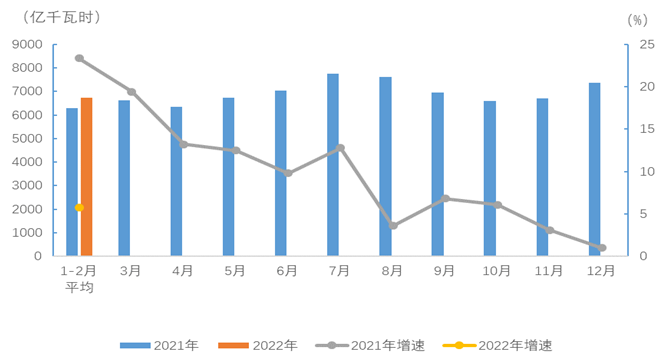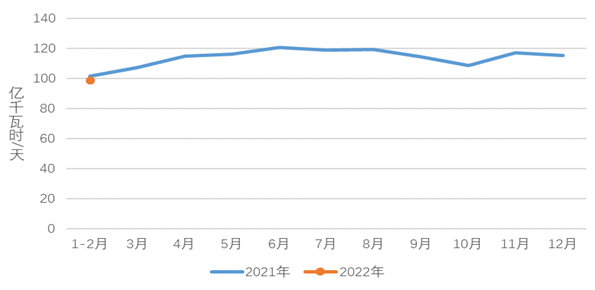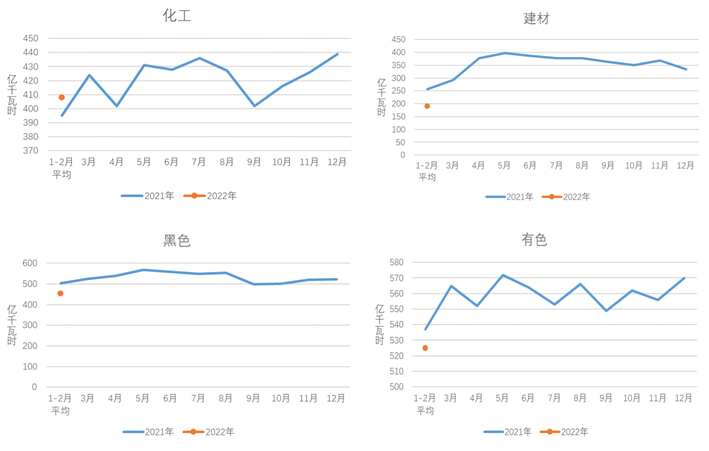
From January to February, the electricity consumption of the whole society increased year-on-year, and the domestic electricity consumption of industry and urban and rural residents maintained double-digit growth; The growth rate of electricity consumption in 17 provinces exceeded the national average; The growth rate of electricity consumption in industry and manufacturing is lower than the average level of the whole society; The electricity consumption of the chemical industry is growing, and the electricity consumption of building materials, black and non-ferrous industries is growing negatively.
First, the electricity consumption of the whole society
From January to February, the country's electricity consumption was 1,346.7 billion kilowatt hours, a year-on-year increase of 5.8%.
In terms of industry (1), from January to February, the industrial electricity consumption was 16.3 billion kWh, a year-on-year increase of 12.8%; the electricity consumption of the secondary industry was 841.3 billion kWh, a year-on-year increase of 3.4%; the electricity consumption of the tertiary industry was 248.8 billion kWh, a year-on-year increase of 7.2%; The domestic electricity consumption of urban and rural residents was 240.3 billion kWh, a year-on-year increase of 13.1%.

Figure 1 Electricity consumption and its growth rate in 2021 and 2022 by month
2. Electricity consumption by region
From January to February, the electricity consumption of the whole society in the eastern, central, western and northeastern regions (2) was 6006, 2666, 3986 and 80.9 billion kWh respectively, with a growth rate of 6.2%, 10.7%, 2.3% and 5.0% respectively.

Fig. 2 Electricity consumption and its growth rate in the whole society in the month by region
From January to February, except for Yunnan, Tianjin and Inner Mongolia, the electricity consumption of the whole society in other provinces achieved positive growth. Among the top five provinces in terms of electricity consumption growth, Tibet grew by 25.1% (Lhasa increased by 19.5% year-on-year, driving Tibet's electricity consumption by 9.5 percentage points), Jiangxi grew by 16.9% (Ganzhou increased by 21.3% year-on-year, driving Jiangxi's electricity consumption by 2.8 percentage points), Hubei grew by 14.8% (Wuhan increased by 17.1% year-on-year, driving Hubei's electricity consumption by 4.6 percentage points), and Anhui grew by 14.5% (of which Hefei increased by 13.5% year-on-year) Zhejiang's growth rate was 11.8% (of which Hangzhou's year-on-year growth was 13.0%, driving Zhejiang's electricity consumption growth by 2.3 percentage points). There are 12 provinces with a growth rate of electricity consumption exceeding the national average, in order: Hainan (10.5%), Jilin (8.6%), Heilongjiang (8.2%), Shanghai (8.2%), Guizhou (8.0%), Jiangsu (7.9%), Shanxi (7.6%), Henan (7.5%), Hebei (7.3%), Sichuan (6.8%), Fujian (6.8%) and Hunan (6.3%).
3. Electricity consumption in industry and manufacturing
From January to February, the national industrial electricity consumption was 825.7 billion kilowatt hours, a year-on-year increase of 3.6%, and the growth rate fell by 22.1 percentage points over the same period last year, accounting for 61.3% of the total electricity consumption of the whole society.
From January to February, the electricity consumption of the national manufacturing industry was 611.6 billion kilowatt hours, a year-on-year increase of 0.5%, and the growth rate fell by 26.3 percentage points over the same period last year. Among them, the total electricity consumption of the four major high-load energy industries was 341.6 billion kWh, down 1.4% year-on-year, and the growth rate was 19.7 percentage points lower than that of the same period last year; the electricity consumption of high-tech and equipment manufacturing industry (3) was 127.2 billion kWh, a year-on-year increase of 3.9%, and the growth rate was 42.9 percentage points lower than that of the same period last year; and the electricity consumption of consumer goods manufacturing (4) was 75.3 billion kWh, a year-on-year increase of 0.1%. The growth rate fell by 37.2 percentage points over the previous year, and the electricity consumption of other manufacturing (5) industries was 67.5 billion kWh, a year-on-year increase of 4.2%, and the growth rate was 25.7 percentage points lower than that of the previous year.

Figure 3 Average daily electricity consumption of the manufacturing industry by month in 2021 and 2022
Fourth, the electricity consumption of high-energy industries
From January to February, the electricity consumption of the chemical industry was 86.1 billion kilowatt hours, a year-on-year increase of 4.9 percent, and the growth rate was 9.4 percentage points lower than that of the same period of the previous year; the electricity consumption of the building materials industry was 47.8 billion kilowatt hours, a year-on-year decrease of 7.0 percent, and the growth rate was 46.4 percentage points lower than the same period of the previous year; the electricity consumption of the ferrous metal smelting industry was 96.6 billion kilowatt hours, a year-on-year decrease of 5.0 percent, and the growth rate was 23.8 percentage points lower than that of the same period of the previous year; the electricity consumption of the non-ferrous metal smelting industry was 111.1 billion kilowatt hours, a year-on-year decrease of 0.1 percent. The growth rate fell by 12.8 percentage points over the same period last year.

Figure 4 Monthly electricity consumption of key industries in 2021 and 2022
Concentrate:
(1) Starting from May 2018, the division of the three industries has been adjusted in accordance with the Notice of the National Bureau of Statistics on Revising the Provisions on the Classification of the Three Industries in < (2012) > (Guotong Guan Han [2018] No. 74).
(2) The eastern region includes 10 provinces (municipalities) including Beijing, Tianjin, Hebei, Shanghai, Jiangsu, Zhejiang, Fujian, Shandong, Guangdong and Hainan; The central region includes 6 provinces of Shanxi, Anhui, Jiangxi, Henan, Hubei and Hunan; The western region includes 12 provinces (municipalities and autonomous regions) of Inner Mongolia, Guangxi, Chongqing, Sichuan, Guizhou, Yunnan, Tibet, Shaanxi, Gansu, Qinghai, Ningxia and Xinjiang; The Northeast region includes three provinces: Liaoning, Jilin and Heilongjiang.
(3) The high-tech and equipment manufacturing industry includes 9 industries: pharmaceutical manufacturing, metal products manufacturing, general equipment manufacturing, special equipment manufacturing, automobile manufacturing, railway/shipbuilding/aerospace and other transportation equipment manufacturing, electrical machinery and equipment manufacturing, computer/communication and other electronic equipment manufacturing, and instrument manufacturing.
(4) The consumer goods manufacturing industry includes 12 industries: agricultural and sideline food processing industry, food manufacturing industry, wine/beverage and refined tea manufacturing industry, tobacco products industry, textile industry, textile and garment/apparel industry, leather/fur/feather and its products and footwear industry, wood processing and wood/bamboo/rattan/palm/grass products industry, furniture manufacturing industry, paper and paper products industry, printing and recording media reproduction industry, and cultural/educational/articular/sports and recreational goods manufacturing industry.
(5) Other manufacturing industries are among the 31 industries classified as manufacturing electricity consumption, except for the four major high-energy industries, high-tech and equipment manufacturing, and consumer goods industries, including: petroleum/coal and other fuel processing industry, chemical fiber manufacturing industry, rubber and plastic products industry, other manufacturing industry, comprehensive utilization of waste resources industry, metal products/machinery and equipment repair industry 6 industries.
Statement: This article is reproduced for the purpose of transmitting more information, if there is a source marked incorrectly or violates your legitimate rights and interests, please contact this website within 30 days, we will correct and delete the time, thank you.
Source: China Electricity Council Statistics and Data Center